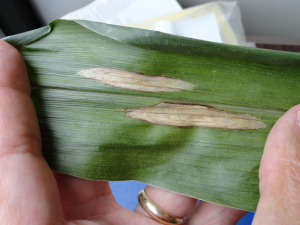Rome Ethredge, extension agent in Seminole County Georgia, this week reported incidence of Northern Corn Leaf Blight (NCLB), as did Jake Price in Lowndes County Georgia. This is a fungal disease that can reduce corn yields and is most likley to be found in fields where corn was grown the previous year.
The following information was from taken Rome’s article on Seminole Crop e-News:
Here are some comments from Dr. Bob Kemerait, UGA Extension Plant Pathologist.
1. Jake Price of Valdosta Georgia area found NCLB on some of his earliest corn (March planting date) that is now waist-high… It has been in the field a while.
2. The field is planted corn-behind-corn…. the spores (conidia) are still around from last year…
3. The field is planted to conservation tillage…. not only are the spores (conidia) still hanging around but they are in the crop debris exactly where we left them last year.
4. Rainfall has been abundant… hence greater splash of spores from the debris to the young leaves and also free moisture to aid in the infection process.
5. It has been cool….. the NCLB pathogen rages in temperatures between 64F and 81F…. sound familiar…
In other words.. we seem to have a perfect storm for northern corn leaf blight this year…….
So, what to do?
Question 1. Should every corn grower in the state of Georgia spray their corn at the 5th-to-6th leaf stage with a fungicide?
Answer 1. No, I don’t think that is necessary…. corn in fields with good rotation and where NCLB is not found when the fields are scouted certainly don’t need to be sprayed for this disease now.
Question 2. Well Bob, what fields would you spray early?
Answer 2. From our research, it is clear that IF NCLB is a problem in a field, it is important to apply a fungicide somewhere around the 5th or 6th leaf stage, preferably with a fungicide other than tebuconazole as I think we have better fungicides for this disease. This application is followed by a second application, somewhere around the silking stage. Growers who should consider this application are 1) NCLB is found in the field already, 2) Growers at high risk to NCLB (see description of Jake’s field…) and/or 3) the grower has very high expectations for yield and very low expectations for risk.
Question 3. What if the grower wants to spray early for NCLB but not too early…
Answer 3. In such case, the grower should continue to scout the field and consider risk factors and then decide just before it becomes too late to spray the field with a tractor-mounted-boom-sprayer.
Question 4. What about the early-tassel spray you always talk about?
Answer 4. I continue to encourage all corn growers with any reasonable yield potential to consider making a fungicide application at the early-tassel growth stage for management of southern rust. However, if our crop is disease free, which I doubt, then this application may not be needed.
More information about fungicide treatments for corn as well as general production information can be found in the University of Georgia Corn Production Guide.
- Carinata Starting to Come Up in Jackson County - December 12, 2014
- Wheat Production Considerations for 2014-2015 - November 10, 2014
- Peanut and Cotton Harvest Video 2014 - November 10, 2014

